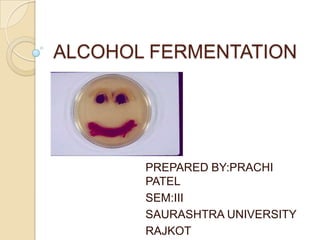Alcohol fermentation
•Télécharger en tant que PPTX, PDF•
161 j'aime•88,416 vues
its all about alcohol production.
Signaler
Partager
Signaler
Partager

Recommandé
Recommandé
Contenu connexe
Tendances
Tendances (20)
Strain development techniques of industrially important microorganisms

Strain development techniques of industrially important microorganisms
Similaire à Alcohol fermentation
Similaire à Alcohol fermentation (20)
1587398881_BT(H)-VI-Industrial_and_Environmetal_Microbiology-1.pdf

1587398881_BT(H)-VI-Industrial_and_Environmetal_Microbiology-1.pdf
Bioethanol production from fruits and vegetable wastes

Bioethanol production from fruits and vegetable wastes
Alcoholic and lactic acid fermentation_lesson 2.pptx

Alcoholic and lactic acid fermentation_lesson 2.pptx
Dernier
Dernier (20)
Micro-Scholarship, What it is, How can it help me.pdf

Micro-Scholarship, What it is, How can it help me.pdf
ICT Role in 21st Century Education & its Challenges.pptx

ICT Role in 21st Century Education & its Challenges.pptx
ICT role in 21st century education and it's challenges.

ICT role in 21st century education and it's challenges.
Beyond_Borders_Understanding_Anime_and_Manga_Fandom_A_Comprehensive_Audience_...

Beyond_Borders_Understanding_Anime_and_Manga_Fandom_A_Comprehensive_Audience_...
HMCS Max Bernays Pre-Deployment Brief (May 2024).pptx

HMCS Max Bernays Pre-Deployment Brief (May 2024).pptx
Interdisciplinary_Insights_Data_Collection_Methods.pptx

Interdisciplinary_Insights_Data_Collection_Methods.pptx
This PowerPoint helps students to consider the concept of infinity.

This PowerPoint helps students to consider the concept of infinity.
Kodo Millet PPT made by Ghanshyam bairwa college of Agriculture kumher bhara...

Kodo Millet PPT made by Ghanshyam bairwa college of Agriculture kumher bhara...
HMCS Vancouver Pre-Deployment Brief - May 2024 (Web Version).pptx

HMCS Vancouver Pre-Deployment Brief - May 2024 (Web Version).pptx
Exploring_the_Narrative_Style_of_Amitav_Ghoshs_Gun_Island.pptx

Exploring_the_Narrative_Style_of_Amitav_Ghoshs_Gun_Island.pptx
Jual Obat Aborsi Hongkong ( Asli No.1 ) 085657271886 Obat Penggugur Kandungan...

Jual Obat Aborsi Hongkong ( Asli No.1 ) 085657271886 Obat Penggugur Kandungan...
Python Notes for mca i year students osmania university.docx

Python Notes for mca i year students osmania university.docx
Alcohol fermentation
- 1. ALCOHOL FERMENTATION PREPARED BY:PRACHI PATEL SEM:III SAURASHTRA UNIVERSITY RAJKOT
- 2. INDEX: INTRODUCTION PROCESS ORGANISMS USED SUBSTRET AND MEDIA COMPOSITION AND IDEAL CONDITION PRODUCT RECOVERY USES CONCLUSION
- 3. alcoholic fermentation, also referred to as, Ethanol fermentation, is a biological process in which sugars such as glucose, fructose, and sucrose are converted into cellular energy and thereby produce ethanol and carbon dioxide as metabolic waste products. Because yeasts perform this conversion in the absence of oxygen ethanol fermentation is classified as anaerobic.
- 4. Conversation Mechanism C6H12O6 C2H5OH + CO2 180 92 88 100 Kg 51.1 Kg 48.9 Kg Theoretical Yield : 51.1% Gay-Lussac Coefficient(1815)
- 5. C6H12O6 ====> 2(CH3CH2OH) + 2(CO2) + Energy (which is stored in ATP) Sugar ====> Alcohol + Carbon dioxide gas + Energy (Glucose) (Ethyl alcohol)
- 6. Organisms used: Bacteria: Zymomonas mobilis Closteridium acetobutylicum Klebsiella pneumoniae Yeast Saccharomyces cerevisiae Saccharomyces carlsbergenesiae Saccharomyces saki Saccharomyces oviformis Candida utilis Mucur sp.
- 7. FERMANTABLE SUBSTRATE Sugary materials Starchy material Cellulosic materials
- 8. SUGARY MATERIALS: Molasses Suger cane Sugar beet Sweet potato Sulfide waste Weet sorgum Whey glucose Succrose Lactose
- 9. STARCHY MATERIALS cereals: wheat,maize,barley,sorgum,corn,rice Roots: potato,tropica Mild products: wheat flour,corn feed
- 11. Fermentation media Nutrient Raw material Carbon molasses, starch Nitrogen corn steep liquor, soybean meal, pure ammonia or ammonium salts, urea, nitrate salts, phosphate salts Vitamins biotin, yeast extract, beef and growth extract, corn steep liquor, factors wheat germ meal
- 12. CONDITIONS FOR FERMENTATION Carbon sources: pure sugar or crude sugars/molasses (10-18%). Nitrogen sources: Mostly available in the form of ammonium sulphate. Growth factors: can be provided in the form of molasses. pH: 4.8-5.0. Temperature: 70-80 F. Temp. can be controlled by cooling jacket.
- 13. CONTN…….. Time: Depends on yeast strain. Usual time is between 30 to 72hrs. Yield: 0.4 gallon of ethyl alcohol per one gallon of molasses. 90% carbohydrates can be converted in to alcohol.
- 14. FERMENTATION PROCESS CARRY OUT BY: batch fermentation Continuous fermentation continuous fermentation is used because of several advantages.
- 15. FERMENTATION Inoculums size: In range of 3% to 10% with an evrage about 4% Media: 10 -18%. Concentrations greater than 20% are not employed as they could be detrimental to yeast.
- 16. PRODUCT RECOVERY Distillation is a separation process for a mixture of liquids or oils. It relies on differences in the boiling points of the component liquids to be separated. Alcohol can be obtained by distillation and column is known as rectified column. Can also be recovered by fractional distillation. Distillate contains 95.6% ethyl alcohol and 4.4% water.
- 18. BY-PRODUCTS Three byproducts generated 1. Carbon dioxide- used for production of dry ice and pure form used for preparation of soft drinks. 2. Yeast biomass- used for animal fodder because it contains high protein, vitamins etc. 3. Distillery effluents- used as a fertilizer and animal feed.
- 19. Ethanol Tolerance Growth Tolerance Production Tolerance Ethanol level Ethanol level at which at which Growth ceases Ethanol production ceases 6-9% wt/vol 15% wt/vol or higher
- 20. USES: Fuels Some alcohols, mainly ethanol and methanol can be used as an alcohol fuel Preservative Solvents Alcohols have applications in industry and science as reagents or solvents ethanol can be used as a solvent in medical drugs, perfumes and vegetable essences such as vanilla
- 21. Alcoholic beverages Antifreeze Antiseptics Ethanol can be used as an antiseptic to disinfect the skin.
- 22. CONCLUSION Thus alcohol production is an important fermentation because of following reasons: 1. Gives ethyl alcohol used for consumption as well as industrial purposes. 2. Gives byproducts like carbon dioxide, yeast biomass, fertilizer etc. 3. Gives effective utilization of agro- waste eg. Molasses, sulphite waste liquor etc.
